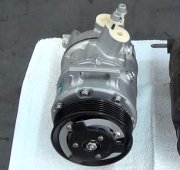I would like to test compressor by wiring a power line to positive of compressor and ground line to negative lead compressor. Then as I have heard, the clutch should activate, click and pull in to make sure it has not internal clutch short.
How can I tell which lead is positive and which is negative?
1) Can I switch those two?
2) Can I just use a nine volt battery? And do the same with the leads (either way)?
I am trying to use information in the 2003 Caravan compressor diagnosis posts as below:
Compressor clutch coil
Diagnosis and testing - compressor clutch coil:
The air conditioning compressor clutch coil electrical circuit is controlled by the power-train control module (PCM) through the compressor clutch relay, which is located in the intelligent power module (IPM) in the engine compartment near the battery. Begin testing of a suspected compressor clutch coil problem by performing the preliminary checks.
Preliminary checks:
If the compressor clutch will not engage, verify the refrigerant charge level. Refer to Refrigerant - diagnosis and testing - refrigerant charge level. If the refrigerant charge level is okay, go to step two. If the refrigerant charge level is not okay, adjust the refrigerant charge as required.
If the A/C compressor clutch still will not engage, disconnect the headlamp and dash wire harness connector for the A/C pressure transducer and check for battery current at the connector with the engine running and the heater A/C control set to the A/C mode. If okay, go to tests. If not okay, use a DRBIII (R) scan tool to perform further diagnosis. Refer to the appropriate diagnostic information.
Tests:
Verify the battery state of charge. Refer to battery - diagnosis and testing.
Connect an ammeter (0 to 10 ampere scale selected) in series with the clutch coil feed terminal. Connect a voltmeter (0 to 20 volt scale selected) to measure voltage across the battery and the clutch coil.
With the heater A/C control in the A/C mode and the blower at low speed, start the engine and allow it to run at a normal idle speed.
The compressor clutch should engage immediately, and the clutch coil voltage should be within two volts of the battery voltage. If the coil voltage is not within two volts of battery voltage, test the clutch coil feed circuit for excessive voltage drop. If the compressor clutch does not engage, use a DRBIII(R) scan tool to perform further diagnosis. Refer to the appropriate diagnostic information.
With the ambient temperature at 21 C (70 F), the compressor clutch coil is acceptable if the current draw is 2.0 to 3.7 amperes at 11.5 to 12.5 volts at the clutch coil. If the voltage is more than 12.5 volts, add electrical loads by turning on electrical accessories until the voltage reads below 12.5 volts.
If the compressor clutch coil current reading is zero, the coil is open and must be replaced.
If the compressor clutch coil current reading is four amperes or more, the coil is shorted and must be replaced.
Thursday, August 10th, 2017 AT 12:53 AM


